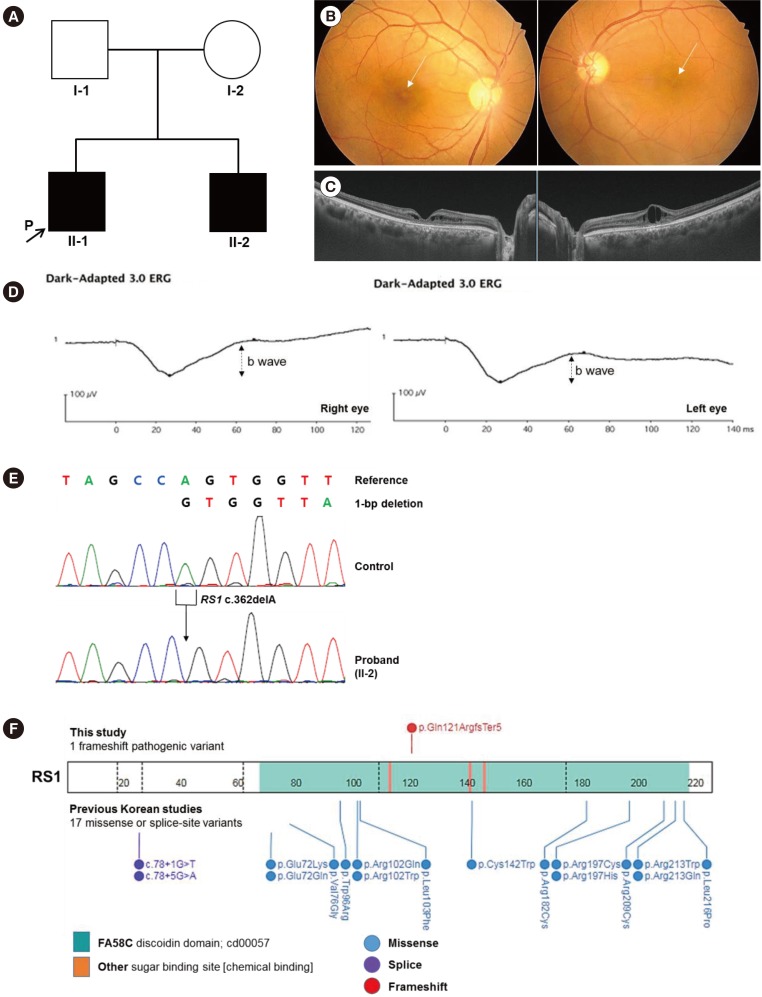Ann Lab Med.
2019 Jan;39(1):109-112. 10.3343/alm.2019.39.1.109.
A Novel Pathogenic RS1 Variant (c.362delA) in a Korean Patient With Late-onset X-linked Retinoschisis
- Affiliations
-
- 1Department of Ophthalmology, Soonchunhyang University College of Medicine, Cheonan, Korea.
- 2Department of Laboratory Medicine and Genetics, Soonchunhyang University Bucheon Hospital, Soonchunhyang University College of Medicine, Bucheon, Korea.
- 3Department of Laboratory Medicine and Genetics, Samsung Medical Center, Sungkyunkwan University School of Medicine, Seoul, Korea.
- 4Department of Ophthalmology, Soonchunhyang University Bucheon Hospital, Soonchunhyang University College of Medicine, Bucheon, Korea. yhohn@schmc.ac.kr
- KMID: 2420282
- DOI: http://doi.org/10.3343/alm.2019.39.1.109
Abstract
- No abstract available.
MeSH Terms
Figure
Reference
-
1. Molday RS, Kellner U, Weber BH. X-linked juvenile retinoschisis: clinical diagnosis, genetic analysis, and molecular mechanisms. Prog Retin Eye Res. 2012; 31:195–212. PMID: 22245536.2. Kim DY, Mukai S. X-linked juvenile retinoschisis (XLRS): a review of genotype-phenotype relationships. Semin Ophthalmol. 2013; 28:392–396. PMID: 24138048.3. Kim DH, Heo SH, Seo GH, Oh A, Kim T, Kim GH, et al. A novel mutation in XLRS1 gene in X-linked juvenile retinoschisis. J Genet Med. 2018; 15:13–16.4. Kim SY, Ko HS, Yu YS, Hwang JM, Lee JJ, Kim SY, et al. Molecular genetic characteristics of X-linked retinoschisis in Koreans. Mol Vis. 2009; 15:833–843. PMID: 19390641.5. Koh HJ, Jwa NS, Kim SS, Lee SC, Kwon OW. A novel mutation in the XLRS1 gene in a Korean family with X-linked retinoschisis. Korean J Ophthalmol. 2006; 20:62–64. PMID: 16768192.6. Korea National Research Institute of Health. Korean Reference Genome Database (KRGDB). Updated on April 2018. http://152.99.75.168/KRGDB.7. Genome Aggregation Database (gnomAD). Updated on April 2018. http://gnomad.broadinstitute.org.8. Richards S, Aziz N, Bale S, Bick D, Das S, Gastier-Foster J, et al. Standards and guidelines for the interpretation of sequence variants: a joint consensus recommendation of the American College of Medical Genetics and Genomics and the Association for Molecular Pathology. Genet Med. 2015; 17:405–424. PMID: 25741868.9. The Human Gene Mutation Database (HGMD). Updated on April 2018. http://www.hgmd.cf.ac.uk/ac/index.php.10. Vincent A, Robson AG, Neveu MM, Wright GA, Moore AT, Webster AR, et al. A phenotype-genotype correlation study of X-linked retinoschisis. Ophthalmology. 2013; 120:1454–1464. PMID: 23453514.
- Full Text Links
- Actions
-
Cited
- CITED
-
- Close
- Share
- Similar articles
-
- A novel mutation in XLRS1 gene in X-linked juvenile retinoschisis
- Bilateral Juvenile Retinoschisis in four Brothers of a Family
- A Novel Mutation in the XLRS1 Gene in a Korean Family with X-linked Retinoschisis
- A pathogenic PHEX variant (c.1483-1G>C) in a Korean patient with X-linked hypophosphatemic rickets
- A rare, likely pathogenic GCK variant related to maturity-onset diabetes of the young type 2: A case report


